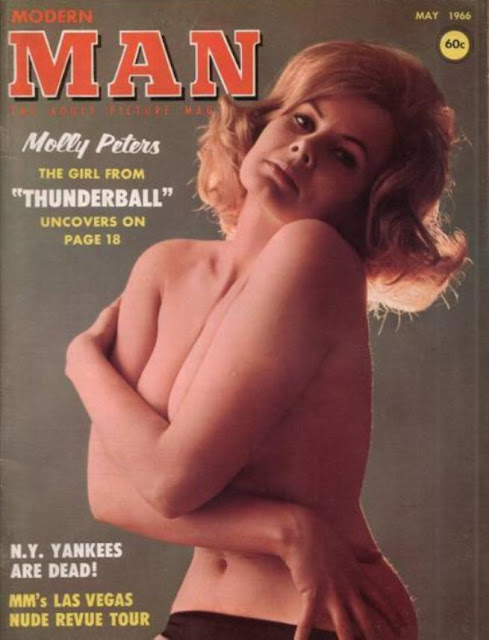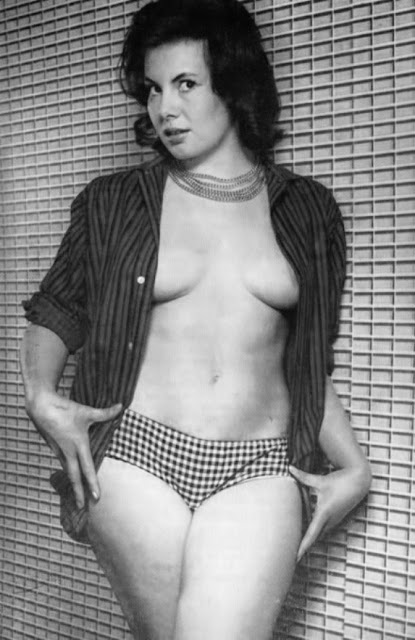Like many people in Britain in the sixties and seventies, the only time my family went to the cinema in a year was when the annual (as they then were) James Bond film was released. I remember a few others that actually got me to the cinema. I remember going to Carry on Cowboy (1965), 2001: A Space Odyssey (1968), One Million Years BC (1966), Thunderbird 6 (1968) (I missed Thunderbirds are Go (1966), which we were due to go to but I was dangerously ill in hospital - as my sister says: 'when you were small you were always basically just on the brink of death' - to which there is some truth), The Jungle Book (1967), The Battle of Britain (1969) and Waterloo (1970). Most of these films, as you can imagine, I was mainly taken too by my father but the Bond films were family outings. Given the amount of implied sex and violence this is rather odd, in retrospect, and now I find it strange, when going to see a Bond at the cinema to see parents with children who are really too young to attend.
Thunderball (1966) was, the last James Bond film I didn't see at the cinema. You Only Live Twice (1967) was the first one, as I mentioned in my post on the Bond films of Roger Moore, recently. My mother and father went to see Thunderball and I remember my mother telling me it was the best one so far (discuss). So I never saw Molly Peters, who died this week, playing therapist Patricia Fearing on the big screen in Thunderball, although I would, no doubt, have been as immune to her charms as I was to Raquel Welch's in One Million Years BC.
I had to wait a long time to see Thunderball as ITV didn't acquire the British TV rights (for £850,000) of the first six Bond films until 1974 and these were then first shown between 1975 and 1977. By 1976, however, I was well aware of Miss Peters' charms when I first saw the (pan and scan) film on TV.
In fact, there was rather too much of Miss Peters' charms on display for the British Board of Film Censors who objected to no less than 32 items in Thunderball and indicated that if it wasn't cut it would be given an 'X' certificate, The scene where Peters gets her naked back massaged by Connery using a mink glove was cut from the British theatrical release, although it was restored for the later video and DVD release.
What did remain, however, was the scene where, after rescuing Bond from a sabotaged back stretching machine, Bond pushes Peters' character into the Turkish bath (despite her saying 'no' -sorry, feminists) and strips her clothes off. Miss Peters' naked back is clearly visible through the steamed up window. However mild it seems today, it was the first nude love scene in a Bond film. which was Peters' claim to cinematic immortality.
This pbotograph, which appeared in Playboy that year, suggests that Peters really was completely naked in the scene or, at least, was for this publicity still.
With director Peter Young on the set of Thunderball
Peters was a model when she appeared as an extra in The Amorous Adventures of Moll Flanders (1965) and was spotted by the film's director, Terence Young, who would go on to direct Thunderball the following year. He encouraged her to try out for the part of Patricia Fearing.
Being an experienced photographic model, the Bond producers were delighted to get Peters to pose for publicity stills wearing (just about) her shorts and blouse outfit from her first appearance in the health farm sequence.
I don't know if they make chest expanders any more but they seemed popular things in small ads in magazines and newspapers in the sixties. Miss Peters seems to enjoy a good stretch, anyway.
The mink massage glove featured in a number of the press stills but the scene of Peters massaging Connery's back with it was cut from the film.
The glove appeared again in a couple of rather more revealing shots which were done for a Bond Girl special in November 1965's Playboy, which also featured an interview with Sean Connery. Playboy had, for many years, a strong association with the Bond producers and this was the first of many pictorials of Bond girls which tied in to new Bond films. It was the top photograph of these which appeared in the magazine.
Peters was a brunette and only dyed her hair blonde for the role in Thunderball, so any shots of her with blonde hair date after this. Men's magazines were keen to exploit the Bond girl connection, needless to say. Here she is in June 1967's Fiesta and on the cover of American magazine Modern Man for May 1966.
Although she was only 22 when Thunderball was made her career never took off and she only appeared in three more films, in 1966 and 1968, and a had a couple of TV appearances in 1967.
She later revealed that she had had a dispute with her manager who would not release her from her contract but wouldn't work actively on her behalf either. By the time her contract expired she had been forgotten. She later got married and lived in Suffolk where she had a son (who pre-deceased her) but suffered a mild stroke in 2011.
A farmers daughter from Walsham-le-Willows in Suffolk, Peters left home for London as a teenager and worked as a nanny and as a shop assistant. Some of her friends suggested that her 37-24-37 figure would get her a job as a glamour model.
She soon picked up work in this field and her first appearance was in one of glamour photographer Harrison Marks' (indeed, he is credited with inventing the term 'glamour photography') magazines in late 1962, when she would have been twenty.
She also posed for photographer Russell Gay, who was the man behind Fiesta and Knave magazines. She appeared under a number of different names, including Carla Houseman, Wanda Wainwright and Joey Milbank. She made a number of short nudist films for Harrison Marks too.
It was usually a requirement for nude models at the time to shave their pubic hair, as its appearance in magazines would have brought charges of obscenity in the early sixties. The rather anatomically frank presentation of her nether regions here would also have got the publishers into trouble so a little retouching would have been necessary on this one.
She also posed for photographer Russell Gay, who was the man behind Fiesta and Knave magazines. She appeared under a number of different names, including Carla Houseman, Wanda Wainwright and Joey Milbank. She made a number of short nudist films for Harrison Marks too.
It was usually a requirement for nude models at the time to shave their pubic hair, as its appearance in magazines would have brought charges of obscenity in the early sixties. The rather anatomically frank presentation of her nether regions here would also have got the publishers into trouble so a little retouching would have been necessary on this one.
However, here is a fully thatched Peters in a series of shots that were taken between 1963 and 1964 but couldn't have appeared in the UK (Marks did produce material for the rather more relaxed Continent).
Nearly all men's magazines in Britain at this time (until Penthouse in 1965, anyway) were small digest sized black and white productions but Peters did have a few colour shoots done, some of which appeared across the Atlantic.
















































A fascinating post - the "Swinging Sixties" were really rather tame! Thunderball was the first Bond I saw at the flicks. Your mother was spot on - it was/is/will be the best ever Bond.
ReplyDelete